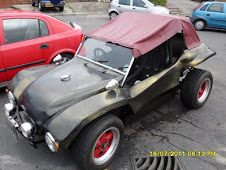22nd April 2012
Last week I successfully relocated my battery so that it sat in the middle of the rear seat panel.I knew that the battery was just lower than the edge of the box I had created and had intentionally made it this way so a lid or cover could be attached over the battery securing it from fingers that may be on the back seat.
I started designing the lid by measuring the aperture in the top of the box. When I created the box I had noted that the two corners that I had used that was already joined flared out slightly and had made my two new corners to look the same. This meant I had to measure the inside area allowing for a 2mm tolerance. You can see in the diagram to the right the sizes marked up. Once I had my measurements I made a paper template this size and put it through a plastic envelope heat sealer to make it plasticized. I found a piece of flat Stainless a tea tray and laid this on the surface so that I would be able to put the fibreglass on top and gauge the size I needed. I layered up four sheets of fibreglass with fibreglass resin this took longer than normal to set because of the weather so I used a paraffin heater to raise the temperature in my workshop.
The matting I applied was just larger than my paper pattern that sat in the A4 plastic heated liner. This is the same machine that does plastic badges. This stopped the fibreglass sheet sticking to the tray. I left this over a day to dry and cure. Once hard the fibreglass was turned over to expose the pattern on the other side. I used an angle grinder to cut through the plastic and fibreglass around the edges of the template pattern so that the sides were clean cut and crisp.
I then removed the template which peeled of leaving a smooth surface The fibreglass panel was then sanded on the opposing side until the thickness of the fibreglass was consistent all over the panel. Once the panel was smooth I painted the rougher side with black Hammerite hammered paint. This sealed the surface on one side. So that I could concentrate on the other. I used Car under seal to spay the other side leaving a rippled effect . This was the same process I had used inside the car.
The underseal surface dried quite quickly leaving a slightly textured surface. This need no further preparation and I was able to spray m 1k black paint onto the surface . This sealed the under seal and fibreglass . I knew I had run out of thinners and would have to buy some more . I wanted to finish the panel and decided to try making up the 2k Lacquer and hardener and adding the gold leaf with a view to using a large brush to apply it.
The finished lacquered panel looked amazing and you really could not tell it had not been sprayed with a spray gun. The panel was then checked for size and it fitted neatly into the top of the box. I had purchased some stainless fixings to secure the top from a boat chandler I offered these onto the lid so that I could gauge how they looked against the finished surface. They fitted in four places and I was able to decide were they would fit.
I attached the eccentric / pull over fastener to the panel with M5 countersunk bolts I used these as I did not want them to interfere with the battery and to be pulled in flush to the fibreglass. Once these were all bolted in place I offered the panel up to the box and marked the positions of the stainless box to locate the eccentric keeps. I fixed theses to the rear of the box through my body bar . I used self tapping screw's to fix the front eccentric keeps.
The lid was latched in place and sat neatly over the battery . The eccentric / pull over latches had little loops on them that either a wire and a single padlock could be used or four separate padlocks could also be used to secure the battery from theft. I was very pleased with this as it made the rear seat area a much safer place to be. I was also wondering whether I could build a seat to go on this new area.






























No comments:
Post a Comment